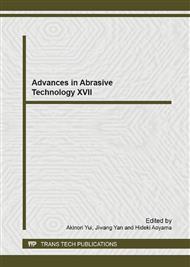p.648
p.654
p.663
p.669
p.675
p.681
p.686
p.692
p.696
Development and Practicality of a Scanning Point Autofocus Instrument for High Speed Areal Surface Texture Measurement
Abstract:
A point autofocus instrument (PAI) is widely used for the roughness and contour measurement of various precision processing surfaces, because it is capable of measuring a large area in high precision. The only disadvantage of PAI is to require a long measurement time. Its conventional index measurement stops the scanning stage in order to obtain each coordinate value of the fixed sampling pitch. Hence, it was necessary to develop a scanning point autofocus instrument (SPAI) which can obtain coordinate values while the scanning stage is moving. As an achievement of the development, the SPAI offers 26 times faster measurement speed than that of the index measurement with equivalent accuracy. The SPAI easily measures 3D surface texture and provides quantitative evaluations of the precision processing surfaces.
Info:
Periodical:
Pages:
675-680
Citation:
Online since:
September 2014
Authors:
Price:
Сopyright:
© 2014 Trans Tech Publications Ltd. All Rights Reserved
Share:
Citation:


